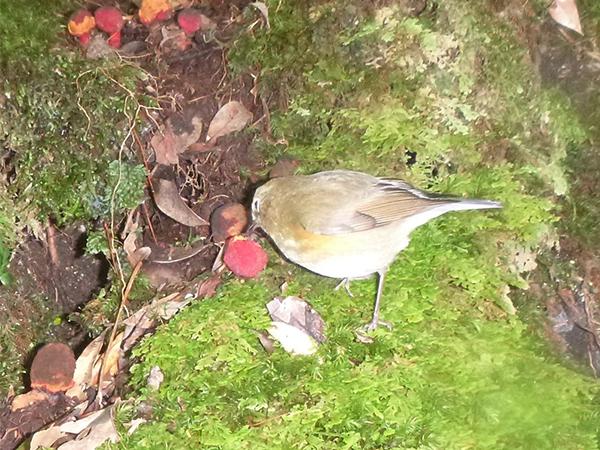Novel seed dispersal system of a mushroom-like non-photosynthetic plant

Credit: Kenji Suetsugu
Balanophora have some of the smallest fruits among angiosperms, leading researchers to question how the seeds of these plants are dispersed. However, very little is currently known about their seed dispersal system. Associate Professor SUETSUGU Kenji (Kobe University Graduate School of Science) documents an unrecognized seed dispersal mutualism between the peculiar, mushroom-like non-photosynthetic plant Balanophora yakushimensis and its avian visitors. The birds obtain nutrients, not from the tiny undernourished fruits, but from the larger fleshy bracts, while B. yakushimensis plants benefit from the seed dispersal. In contrast to well-studied fleshy-fruited plants, the dry-fruited Balanophora species has adopted an avian seed dispersal mutualism through its fleshy bracts, which act as both visual attractants and nutritional rewards. These findings were published on 19 August, 2020 in ‘Ecology’.
The color green is a defining feature of the plant kingdom, and plants are mostly assumed to be autotrophs that can make their own food from simple inorganic substances such as carbon dioxide. Therefore, the biological oddities of non-photosynthetic plants have long attracted the attention of naturalists. The genus Balanophora comprises partially or entirely subterranean non-photosynthetic plants with extremely reduced morphological features. Just like the most famous parasitic plant Rafflesia, Balanophora mooch water and nutrients off the host plants they are attached to. Consisting of highly specialized root parasites, Balanophora is definitely one of the most unusual plant genera (Figure 1).
Recent studies have suggested that the evolutionary transition to full heterotrophy is a complex process, although, superficially, it may seem like a loss of photosynthetic ability. One of the most significant characteristics is the extreme reduction in the size and complexity of their seeds. In fact, Balanophora infructescences contain 100,000 to 1,000,000 tiny dry fruits situated at the base of a fleshy, club-shaped transformed bracts (Figure 2). As Balanophora fruits are some of the smallest among angiosperms, the fundamental question arises as to what mode of seed dispersal occurs in these plants.
Yet surprisingly, almost nothing is known about the seed dispersal system of Balanophora, despite this being one of the most important aspects of plant biology. Due to Balanophora infructescences being morphologically similar to mushrooms, it had been assumed that mycophagous rodents were its main seed dispersers. However, the lack of information about the animals that actually feed on Balanophora fruits has prevented the elucidation of the seed dispersal system employed by the group.
Suetsugu studied the B. yakushimensis seed dispersal system in the understory of the temperate forests on Yakushima Island, Kagoshima Prefecture, Japan. Consequently, he documented a previously unnoticed seed dispersal mutualism between the dry-fruited B. yakushimensis and its avian visitors (Figure 3; Video). Even though plants have evolved various mechanisms to mediate seed dispersal by animals, the predominant strategy is the production of fleshy fruits with embedded seeds. However, B. yakushimensis have adopted alternative approaches; not tiny undernourished fruits but larger fleshy bracts act as a tool to elicit seed dispersal. Since the bright red transformed bracts are much larger than their minute fruits, they should function as the primary visual attractants and edible rewards for birds. Overall, the study documents a previously unrecorded seed dispersal mutualism; avian visitors obtain nutrients from transformed bracts, while B. yakushimensis plants benefit from seed dispersal. Further studies on the seed dispersal systems of other Balanophora members will provide greater insights into ecology of these bizarre plants.
###
Video
Video showing the Red-flanked bluetail Tarsiger cyanurus simultaneously consuming both the fleshy bracts and dry fruits of Balanophora yakushimensis: https:/
Journal Information
Title:
“A specialized avian seed dispersal system in a dry-fruited non-photosynthetic plant, Balanophora yakushimensis”
DOI: https:/
Authors:
Kenji Suetsugu
Journal:
Ecology
Media Contact
Verity Townsend
[email protected]
Original Source
https:/
Related Journal Article
http://dx.




